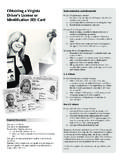Transcription of Gender Identity in Schools
1 Gender Identityin SchoolsQ uestions& Answers:Our mission is to promote and protect the health of Canadians through leadership, partnership, innovation and action in public Health Agency of CanadaPublished by authority of the Minister of publication can be made available in alternative formats upon request, and can also be found on the Internet at the following address: en fran ais sous le titre : Questions & r ponses : L'identit sexuelle l' coleCorrespondence:Sexual Health & Sexually Transmitted Infections Section Community Acquired Infections DivisionCentre for Communicable Diseases and Infection ControlInfectious Disease Prevention and Control BranchPublic Health Agency of Canada Ottawa, Ontario K1A 0K9 Fax: (613) 957-0381 Email: Her Majesty the Queen in right of Canada, 2010 Catalogue number: HP5-97/2-2010E-PDFISBN: 978-1-100-15122-9Q uestions& Answers: Gender Identityin SchoolsTable of ContentsPreface and Acknowledgements.
2 IIntroduction .. 1 What do we know about Gender Identity ? .. 1 Are all Gender variant individuals gay, lesbian or bisexual? .. 2 Have Gender variant individuals always existed? .. 2Do people choose to be Gender variant? .. 3 There are many terms to discuss Gender identities. What are the proper terms and how do I know when to use them? .. 3 There are no Gender variant youth in my school . Why address these issues? .. 3 What are the health, safety, and educational concerns of Gender variant students in our Schools today? .. 4 Harassment and Verbal Abuse .. 4 Mental Health .. 4 Suicide .. 5 Hormone Therapy .. 5 Other Health Risks .. 6 What do I do if a student discloses a Gender variant Identity to me?
3 6 What can the Schools do to support Gender variant youth? .. 7 Provide a Safe Environment .. 7 Develop school -wide Policies .. 7 Professional Development Opportunities .. 8 Raise Awareness .. 9 Challenge Gender Norms .. 9 What can the Schools do to support the parents/caregivers of Gender variant youth? .. 9 How can the Schools build resiliency among Gender variant youth? .. 10 Concluding Remarks .. 11 Additional Resources .. 12 Endnotes .. 18 PrefaceFirst published in 1994 and revised in 2003 and 2008, the Public Health Agency of Canada s Canadian Guidelines for Sexual Health Education (Guidelines) were developed to assist profession-als working in the area of health promotion and sexual health education in programming which supports positive sexual health outcomes.
4 Feed- back from a national evaluation of the Guidelines indicated the need for companion documents to provide more detailed information, evidence and resources on specific issues. In response, the Public Health Agency of Canada (PHAC) identified a question and answer format as an appropriate way to provide information to educators and other professional working with school -aged populations. The Questions and Answers styled documents are intended to cover a range of topics reflecting current issues in sexual health education with school -aged populations, are evidence-based and use inclusive language as reflected in the document, Questions & Answers: Gender Identity in Schools , is intended to address the most commonly asked questions regarding the Gender Identity of youth in school settings.
5 The goal of this resource is to assist educators, curriculum and program planners, school administrators, policy-makers and health professionals in the creation of supportive and healthy school environments for youth struggling with issues of Gender Public Health Agency of Canada would like to acknowledge and thank the many contributors and reviewers who participated in the creation of Questions & Answers: Gender Identity in Schools . The development of this document was made possible through the valuable input provided by experts working in the field of sexual health education and promotion across Canada, including the members of the Sexual Health Working Group of the Joint Consortium for school Health.
6 A complete list of the external reviewers can be found online at: addition, the Public Health Agency of Canada would like to acknowledge the staff of the Sexual Health and Sexually Transmitted Infections (STI) Section, Centre for Communicable Diseases and Infection Control, for their contribution to the development of this & Answers: Gender Identity in Schools1 Questions & Answers: Gender Identity in SchoolsIntroductionThe term Gender was first used in the 1950s to differentiate the set of feelings and behaviours that identify a person as male or female , from their anatomical sex which is determined by their chromosomes and genitals1. Gender is now understood as the roles and relationships, personality traits, attitudes, behaviours, values, relative power and influence that is attributed to males and females by Gender is one of the most basic elements of human Identity .
7 Gender is so fundamental to our Identity , that without being aware of it, many aspects of human life are structured by and reveal our Gender . Throughout the life course3, everyone subconsciously acts out Gender and reflects Gender in various ways, including their dress, mannerisms, and recreational activities. These actions and reflections form components of our Gender Identity or our sense of being male , female or something other than these traditional people mistakenly assume that our Gender Identity is defined by our anatomical sex. In the majority of cases, people s Gender Identity is consistent with their anatomical sex. However, some people feel and express a Gender Identity that is not the same as their biological sex.
8 These inconsistencies can cause a great deal of distress and confusion to individuals, their families and their friends. Gender Identity issues can also cause a great deal of anxiety among professionals working with these individuals, who may not feel informed and competent enough on this topic to provide support. This document provides answers to some of the most common questions that educators, parents/caregivers, school administrators, and health professionals may have about Gender Identity in the Canadian school context. The answers provided in this resource are based on up-to-date evidence and research. These Questions and Answers on Gender iden-tity are designed to support the implementation of the Canadian Guidelines for Sexual Health Education5 (Guidelines).
9 The Guidelines are premised on the belief that comprehensive sexual health education should reflect the diverse needs and realities of all people, and should be pro-vided in age-appropriate, culturally-sensitive, and respectful manner, inclusive of Gender diversity. This Questions and Answers resource is targeted at helping educators (in and out of school settings), curriculum and program planners, school administrators, policy-makers and health professionals implement the Guidelines to ensure that:1 sexual health educational programming is inclusive of the pressing health, safety, and educational needs and challenges of Gender variant youth; 2 the experiences of Gender variant youth are included in all facets of broadly-based and inclusive sexual health education.
10 And 3 educators, admin-istrators, and school board personnel are provided with a more thorough understanding of the goals and objectives of broadly-based and inclusive sexual health education. What do we know about Gender Identity ?The term Gender Identity refers to an individual s sense of self as male , female or an Identity between or outside these Gender VARIANT: A term to refer to individuals whose expres-sions of Gender do not conform to the dominant Gender norms of masculinity and Identity : A person s internal sense or feeling of being male or female, which may or may not be the same as one s biological & Answers: Gender Identity in SchoolsThe majority of people have a Gender Identity that matches their anatomical sex and/or that matches societal expectations for males and females.






